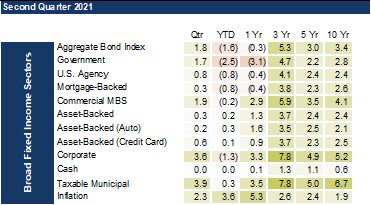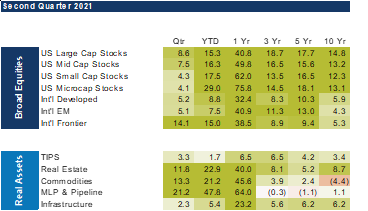Asset Liability Immunization Strategy (ALIS) Insights 3rd Quarter 2021 Outlook
State of the Markets
Unlike the first quarter where we saw interest rates rise in anticipation of stronger growth, the realization of a stronger economy has resulted in rates falling over the second quarter. For example, the 10-year Treasury yield fell by 27 basis points and the long 30-year bond yield declined by 30 basis points. Despite commodity prices moving higher, homes selling for more than list, a waiting list to buy most major appliances, and labor costs rising, the Fed has assured us they will keep short-term rates near zero through 2022. A miscalculation by the Fed with respect to inflation will have significant ramifications. Chairman Powell has indicated inflation will be transitory. This poses a large risk to the capital markets because if the committee is wrong, longer term interest rates will rise sharply, and the stock market will see significant declines. Economic activity will stall, and the lower income wage earners (the group he is trying to help) will be hurt the most. Ultimately, the Fed’s credibility will be negatively impacted for years which will impact their ability to meet their mandate of price stability and full employment.
Stocks produced another quarter of positive returns, extending their growth for the fifth consecutive quarter. The S&P 500 advanced 8.5% over the seond quarter bringing the one-year total to 40.8%. Small caps outperformed on a year-to-date and one-year basis driven by the financial and industrial sectors. Real assets continued to exhibit their strong returns that were evident during the first quarter. It is obvious the capital markets have the same inflation view as the Federal Reserve. If they are both wrong, the Fed may need to slam on the brakes rather than simply ease off the gas pedal.
Pension Plan Index Update
Pension discount rates moved in a similar fashion to that of the greater Treasury market, losing approximately 38 bps as evidenced by the single discount rate, although the middle to long end of the curve is now below levels seen at the end of 2019. The decrease resulted in increased present values of pension liabilities which may have been offset by the performance of the investment portfolio. The degree of offset was dependent on the construction of the portfolio and allocation across the differing asset classes. The Milliman 100 Pension Funding Index is a good source to examine how the correlation of those two pieces of the funding puzzle affected the overall funding level during past periods. The impact over the prior quarter was a reduction in the average funded status by -1.6%, while the year-to-date progress remains positive measuring +6.9%. Currently the index measures a funded ratio of 97.2% while one year ago it measured 84.6%. For the period ending, the average asset return came in at 5.02% while the liability returns measured 2.49%. This type of correlation provides the perfect environment to consider stabilizing the funded ratio using an Asset Liability Immunization Strategy (ALIS). We believe that plan sponsors too often focus solely on the total return of plan assets without paying attention to how interest rates affect the liability valuations. This market environment has provided unique positive progress in funding and offers an opportunity to capture the momentum if an immunization strategy is implemented before the relative performance dissipates.
Fixed-income returns across most bond sectors were positive over the quarter, with both higher quality and longer duration securities outperforming that of lower quality and shorter duration securities, a complete reversal of the prior quarter. 5-year return trends remained positive, favoring lower quality and longer maturities. Compensation for credit risk in the form of credit spreads decreased over the quarter by 11 bps for investment grade debt and 32 bps for high yield debt. Compressing credit spreads convey a richening of the bond market and translate into an improving economic environment.
Risk assets provided a similar sentiment with positive quarterly performance. The best performing sector was the energy MLP & Pipeline sector. Many 1-year return values look extraordinary although we would suggest you consider the base effects of calculating percent change and consider where the state of the capital markets was a year ago.
Economic Outlook
We believe the second half of the year will offer an evolving degree of false certainty including politics, a developing inflation story, the employment environment, and Fed policy. Prior to the conclusion of the 3rd quarter, the physical and social infrastructure investment plans will be hot topics. President Biden recently announced a bipartisan agreement on a $579 billion physical infrastructure deal, a significant reduction from the nearly $2 trillion sought. He also announced the bipartisan deal would only be signed if it were accompanied by a $2 trillion social infrastructure spending bill. The battle that now ensues is not Republicans versus Democrats, rather it seems the final deals will be hashed out between the progressive and moderate Democrats. Our expectation is that the progressives will determine it would be better to get a combined package of $3 trillion than it would be to walk away empty-handed. Mid-term elections are just around the corner and another hit of spending will be helpful to their re-election efforts. Two wild card scenarios to watch out for include a “scorched earth” event where progressives decide that infrastructure investments must exceed $4 trillion, or they will accept no deal. The other possible unexpected outcome is an extension of the enhanced unemployment benefits to give working families the chance to get the right job rather than just any job. Such a program could easily be intertwined with any number of moves toward a universal basic income effort. We think both events would cause major market disruptions. Mechanically, look for Democrats to pass the legislation in the Senate using budget reconciliation to get around the filibuster. Congress will vote on an outline of the tax and spending program in July, but they likely will not take up the final legislation until September.
Inflation concern is a topic for reasonable discussion and disagreement. There are areas where dramatic signs of inflation exist, but in many cases, they will prove to be transitory. A couple of other areas have yet to be determined, or they have exhibited signs of inflation in segments of the economy that we believe are less prone to price corrections.
The Fed’s expectation that broadly, inflation will be transitory, has driven the continuation of their accommodative stance. Real GDP growth expectations for 2021 are 6.6%, with the second quarter annualizing at what is expected to be a peak of 10% growth. It would be the strongest year since 1983. The same base effects that are making the growth and inflation numbers look so strong this year will likely make the growth and inflation numbers look underwhelming in 2022. Mark Zandi, chief economist at Moody’s, estimated that without more spending programs, growth could slip to 1.5% to 2% in the second half of 2022. Others have speculated that the passage of more spending could add between 0.5% and 1.5% to GDP.
To this point, most of the signs of inflation have been in goods rather than services. Goods have seen growth accelerate 5.3% over the past year, the strongest number since 1991, while core services inflation is up a surprisingly modest 0.30%. Much of the recent rise in the CPI data is explained by reopening areas such as airfare, used vehicles, vehicle rentals, and sporting admissions, all up 10% from March to April. Commodities made headlines earlier in the year. Lumber in particular saw futures prices hit roughly $1,700 and have since plummeted to just over $700. The issue with lumber was not a lack of supply, but a bottleneck at the mills and transportation challenges. It is a good example of how perceived supply shortages can lead to dramatic signs of inflation that are subsequently addressed. Many of these out-of-control signs of inflation will turn out to be transitory.
Expect housing costs to be a pain point for the foreseeable future and an area of non-transitory inflation.
Perhaps less transitory is the impact that lumber prices had on new home construction, which may have trickled through to the existing home and rental markets. The soaring lumber costs added roughly $35,000 to the cost of a new single-family home and accounts for 17% of the average new home’s construction cost. Low-cost financing is also contributing to buyers’ ability to tolerate increasing purchase prices. According to the website Apartment List, the median rent has increased 9.2% for the first six months of 2021. The March 2021 release of the Case-Shiller Housing Price Index showed that existing home prices increased more than 13% as compared to a year earlier. Combine the increased housing costs with elevated fuel costs, which based on supply and demand dynamics should see price support for some time, and the average person may feel the nagging effects of non-transitory inflation chiseling away at their disposable income. The substitution for high rents is not a quick or easy transition; it involves saving money for a down payment on a house or changing legislation to reduce the requirements to benefit from U.S. government agency-backed mortgage financing. Expect housing costs to be a pain point for the foreseeable future and an area of non-transitory inflation.
The 800-pound gorilla in the room is the most important cost that will drive all other forms of inflation: labor costs. There may be some legitimacy to the claim that childcare is hampering the employment pursuits of some job seekers, but the enhanced unemployment benefits, where roughly 2/3 of the recipients are better off collecting benefits and not working, explains why we have 7 million more job seekers looking for work opportunities than was the case before the pandemic. Less mentioned is the fact that businesses report that they have 9.2 million available positions, 2 million more than in February of 2020. Also of interest, private sector job “quit” rates are the highest they have been in more than 20 years. Perhaps high-quality workers, or those with special skill sets, are using the current labor market to switch jobs and possibly increase wages. For low-skilled labor, their best hope may be that government efforts to sideline some lower-wage workers will artificially increase their future pay. According to the Forbes website, a Minnesota resident who is receiving enhanced unemployment benefits, receives the equivalent of more than $17/hour. Many people say that wages are a sticky cost, but in low-wage and low-skill tasks, turnover tends to be high and over time, productivity enhancements can be implemented. As an example of how the market is addressing employee scarcity challenges, Southwest Airlines announced they are increasing their wages to $15/hour. Around the same time, FedEx announced that they were increasing capital spending by 20% over the next year to invest in 16 automated facilities. Labor markets hold the key to the more meaningful long-term inflation outlook and the Fed’s resulting policy reaction. Unfortunately for all the job seekers out there, an odd development that caused average hourly earnings to spike last year, possibly resulting from employers laying off their lowest-paid workers first, may cause wage growth headwinds. Once the pandemic-related labor market safety nets are removed, a glut of lower-skilled and lower-wage workers will hit the job market, possibly causing unemployment numbers to get worse and it could very well drag hourly earnings growth numbers lower.
Fed policy has been extremely accommodative throughout this pandemic episode. They must operate in a way that maintains credibility, supporting their dual mandate, while not causing market dependence on monetary stimulus. Real yields, as measured by the 10-year Treasury yield minus the headline inflation rate, have dipped as low as negative 3.7% in 2021. For context, over the past 70 years, real yields have only been lower for 10 months (during 1974 and 1980). Through their security buying programs and other credit spread manipulation efforts, as compared to the current level of inflation, it almost costs nothing to borrow money – even for high-risk, junk-rated borrowers. Some of the Fed efforts may have contributed to the most worrisome areas of inflation. Specifically, the Fed purchasing $40 billion a month of new mortgage-backed securities has kept mortgage financing costs near all-time lows. Cheap financing factors into overall home price affordability and as a result purchase prices have quickly moved higher. If inflation shows convincing signs of being transitory, the Fed will need to do a masterful job of coaching the market to believe that moving toward a self-sustaining economy is a good thing. We expect it will be a bumpy ride as economic signals confirm and refute whether inflation is well-behaved and in line with the Fed’s stated targets.
There are signs that the market has belief that the Fed may be pursuing the correct course of action.
There are signs that the market has belief that the Fed may be pursuing the correct course of action. The yield curve has flattened which suggests that people expect that at a point, the Fed will remove some accommodation and raise short-term rates. It also indicates that the outlook for run-away inflation is muted. Through the Fed’s Dot Plot, released after each meeting, the current expectation of the voting members of the FOMC anticipate two rate hikes in 2023. Perhaps even more interesting is the start of discussions regarding the eventual tapering of asset purchases, which is now anticipated to start at the end of 2021 or the first half of 2022. We find it worthy of noting that only two more FOMC members will have to vote to move their “Dots” into 2022 to have a majority of FOMC members anticipating a rate hike in 2022. The Fed has many tools to fight inflation; it is disinflation that has plagued them for much of the past 13 years. We anticipate after a short visit with inflationary pressures during the next six months to a year, the Fed will have to continue the struggle with disinflation while trying to ween the market off its dependance on monetary stimulus.
In the near term, we expect that shock and awe spending will cause interest rates to rise in the next six months. Once the government’s unsustainable spending allows for clearer price signals and the realization of how the investments will be funded, we may resume demand softness next year. For context, President Biden is proposing an expansion of government spending, from 20% of GDP before the pandemic to 25%. The “trickle up” economic model, where money is transferred from savers and investors to consumers, should weigh on future productivity growth, and by extension it may be an economic drag. Offsetting some of the future disinflationary pressures may be the adoption of green energy mandates. That is not to say we do not like having environmentally friendly options and technology, but just about every new technology is expensive at first, and mandates will hurt lower income families disproportionately for a while. For them, it will be phantom inflation that will cause them to pay more for no functional benefit.
We are passionate about fostering creative ideas and exploring new opportunities for the benefit of pension plan clients. Please contact your ALIS representative at Advanced Capital Group to learn more on how we can assist with your defined benefit investment management needs.
This Newsletter is impersonal and does not provide individual advice or recommendations for any specific subscriber, reader, or portfolio. This Newsletter is not and should not be construed by any user and/or prospective user as, 1) a solicitation or 2) provision of investment related advice or services tailored to any particular individual’s or entity’s financial situation or investment objective(s). Investment involves substantial risk. Neither the Author, nor Advanced Capital Group, Inc. makes any guarantee or other promise as to any results that may be obtained from using the Newsletter. No reader should make any investment decision without first consulting his or her own personal financial advisor and conducting his or her own research and due diligence. To the maximum extent permitted by law, the Author and Advanced Capital Group, Inc., disclaim any and all liability in the event any information, commentary, analysis, opinions, advice and/or recommendations in the Newsletter prove to be inaccurate, incomplete, or unreliable, or result in any investment or other losses. The Newsletter’s commentary, analysis, options, advice, and recommendations present the personal and subjective views of the Author and are subject to change at any time without notice. The information provided in this Newsletter is obtained from sources which the Author and Advanced Capital Group, Inc. believe to be reliable. However, neither the Author nor Advanced Capital Group, Inc. has independently verified or otherwise investigated all such information. Neither the Author nor Advanced Capital Group, Inc. guarantee the accuracy or completeness of any such information.




